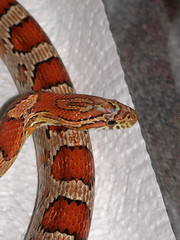A post-hibernation update
Between the date you bring your snakes out of hibernation and the date your female snake lays its first clutch of eggs (or has its first litter, if it’s a live bearer), the challenge is to get as much food into that snake is possible. For most snakes with healthy appetites, that’s not a problem, but there are some exceptions.
For example, my female Great Basin gopher snake has gone off her feed for extended periods during the summer — she’s from a Canadian bloodline, so I think she’s aestivating when that happens. In her case, it seems that hibernation actually helps her appetite, though.
 Pretzel, our female corn snake, presents some special problems. Nothing wrong with her appetite, but she’s a small snake (for a corn snake) and she puts almost all her energy into egg production. When she’s done laying her clutch of 10 to 13 eggs, there’s not much left of her. And she routinely lays two clutches a year. So she has to be fed up — a lot — in the periods between clutches and before and after hibernation if I’m going to keep breeding her. (That, or I’m going to have to keep the always-eager Trouser away from her.)
Pretzel, our female corn snake, presents some special problems. Nothing wrong with her appetite, but she’s a small snake (for a corn snake) and she puts almost all her energy into egg production. When she’s done laying her clutch of 10 to 13 eggs, there’s not much left of her. And she routinely lays two clutches a year. So she has to be fed up — a lot — in the periods between clutches and before and after hibernation if I’m going to keep breeding her. (That, or I’m going to have to keep the always-eager Trouser away from her.)
This is where the problem of high hibernation temperatures comes in. I have learned, though I forget the exact numbers, that for every x degrees the temperature drops, a snake’s metabolism is halved. Regardless of the exact numbers, the bottom line is that if the snake is hibernated at too warm a temperature, it’ll lose weight during hibernation, which of course is not good.
Which is a long way of saying that thanks to two (relatively unsuccessful) clutches last year and a relatively warm hibernation, Pretzel’s kind of skinny right now, and is getting as many mice as I can throw at her. I hope I can fatten her up enough before Trouser knocks her up again.
Meanwhile, I don’t think the hognose snakes were ready to come out of hibernation: they’ve refused their meals twice since emerging. Hmm.